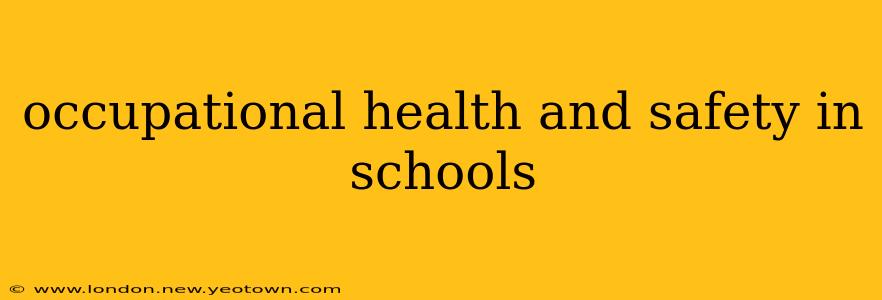Schools are bustling environments, filled with the energy of students and the dedication of staff. But beneath the surface of learning and growth lies a crucial element often overlooked: occupational health and safety (OHS). Ensuring a safe and healthy environment for everyone in a school—teachers, support staff, administrators, and students—is not just a legal requirement; it's a moral imperative. This comprehensive guide delves into the multifaceted world of OHS in schools, exploring key aspects and addressing common concerns.
Imagine this: Ms. Johnson, a dedicated teacher, trips on a loose floorboard, injuring her ankle. Or Mr. Lee, the school janitor, suffers from repetitive strain injury due to improper lifting techniques. These scenarios, sadly, aren't uncommon. The consequences can range from minor injuries to long-term health problems and even fatalities. That's why a proactive and comprehensive approach to OHS is essential.
What are the key aspects of occupational health and safety in schools?
Occupational health and safety in schools encompasses a wide range of measures designed to prevent accidents and illnesses. It's about creating a working and learning environment free from hazards that could compromise the well-being of staff and students. Key areas include:
-
Hazard Identification and Risk Assessment: This is the cornerstone of any effective OHS program. It involves systematically identifying potential hazards (e.g., slippery floors, broken equipment, aggressive students) and assessing the associated risks. This process should involve staff at all levels, fostering a culture of safety awareness.
-
Emergency Preparedness and Response: Schools need robust emergency plans to deal with various situations, including fires, lockdowns, natural disasters, and medical emergencies. Regular drills and training are crucial to ensure everyone knows what to do in case of an emergency.
-
Ergonomics and Workplace Design: Creating a comfortable and ergonomically sound workspace is vital, particularly for teachers who spend long hours sitting or standing. This involves providing adjustable chairs, proper lighting, and ensuring workstations are designed to minimize strain and fatigue.
-
Manual Handling: Many school staff engage in manual handling tasks, such as lifting heavy boxes or moving furniture. Providing proper training in safe lifting techniques and using appropriate equipment can prevent injuries.
-
Chemical Safety: Schools use various cleaning products and chemicals. Proper storage, handling, and disposal are crucial to prevent exposure and accidental ingestion. Staff should receive adequate training on the safe use of these substances.
-
Violence Prevention: Schools can be susceptible to violence, both from students and external sources. Implementing strategies to prevent and manage violence, including clear policies and procedures, is paramount.
-
Mental Health and Wellbeing: The pressure and demands placed on school staff can significantly impact their mental health. Promoting a supportive and understanding work environment and providing access to mental health resources is essential.
What are the legal responsibilities regarding occupational health and safety in schools?
Legal requirements for OHS in schools vary depending on location, but generally, schools have a legal obligation to provide a safe and healthy working environment for their staff and a safe learning environment for their students. This often involves complying with relevant legislation, regulations, and standards. Failure to comply can lead to significant fines and legal repercussions.
How can schools improve occupational health and safety?
Creating a culture of safety is paramount. This involves:
-
Regular training and education: Providing staff with regular training on OHS procedures and best practices is crucial.
-
Open communication and reporting: Encouraging staff to report hazards and near misses without fear of reprisal.
-
Regular inspections and maintenance: Conducting regular inspections of the school premises to identify and address potential hazards.
-
Involving staff in OHS decision-making: Involving staff in the development and implementation of OHS policies and procedures.
-
Providing appropriate personal protective equipment (PPE): Ensuring staff have access to appropriate PPE, such as safety glasses, gloves, and hearing protection, where necessary.
What are the common causes of accidents in schools?
Common causes of accidents in schools include slips, trips, and falls; inadequate lighting; poorly maintained equipment; and insufficient training.
How can I report a safety concern in my school?
Reporting mechanisms vary depending on the school, but there should be clear procedures for reporting safety concerns. This might involve speaking to a supervisor, completing an incident report form, or contacting a designated safety officer.
What resources are available to help schools improve their occupational health and safety?
Many organizations offer resources and support to schools to improve their OHS practices. These resources might include guidance documents, training materials, and consultancy services.
By prioritizing occupational health and safety, schools not only fulfill their legal obligations but also create a more positive and productive learning and working environment for everyone. A safe school is a thriving school, where everyone can focus on what truly matters: learning and growing.

